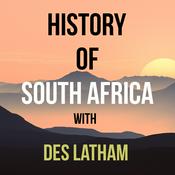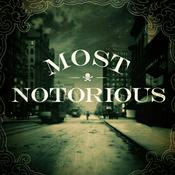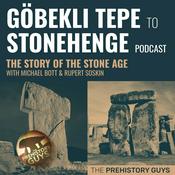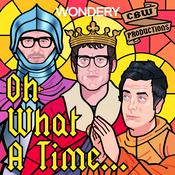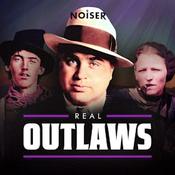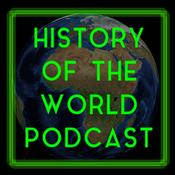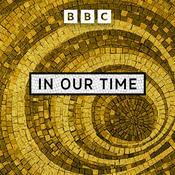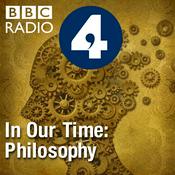256 episodes
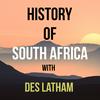
Episode 254 - Skop, Skiet and Donner on the Day of the Dead Moon
2025/12/21 | 21 mins.
The morning of January 22, 1879, dawned with a deceptive, stillness across Zululand masking the fact that over 45,000 men were in motion across a 200 kilometer front, each group operating in a vacuum of information that would, by sunset, shatter the British Victorian ego. At the coast, Colonel Charles Pearson’s Column No. 1 represented the textbook invasion. His force was a heavy, industrial machine led by the 3rd Foot regiment, the Buffs, along with the 99th Regiment, and the Naval Brigade dragging their heavy Gatling guns and artillery. By 5:00 AM, the 5000 strong column was already a dusty serpent stretching more than 8 kilometers back toward the Tugela River. Pearson’s scouts were a mix of the Natal Native Contingent and European volunteers who pushed through the tall grass toward the Nyezane River. They were being observed on Wombane mountain by the uDududu, iMbube, and isigQu regiments - 6,000 warriors under the command of Godide kaNdlela. Wombande mountain lay on the wagon trail between Gingingdlovu on the coastal flats, and Eshowe where Pearson was hoping to setup a main base at the abandoned Norwegian mission station before pushing on to ONdini and Cetshwayo’s HQ. The Zulu plan was traditional, await in complete stillness on the high-ground then sweep in for a surprise ambush. Pearson’s advance guard crossed the Nyezane River and crossed over at 7.30am. Thick bush grew all around, the cavalry was reconnoitering and saw nothing. Vedettes, or mounted guards, were placed to keep an eye out for the Zulu army. Pearson’s main party reached the knoll selected for the first stop at around 8am, and the men began to outspan their oxen for a late breakfast. As the laager was being formed up, a party of the Natal Native Contingent who scouted ahead attracted fire from Zulu snipers. The latest Zulu tactic which would also be repeated at Isandlwana, Rorke’s Drift, and as Evelyn Wood would report later from Hlobane mountain - a combination of heavy fire from high ground in support of a surging attack by warriors on foot. The road was a now completely commanded by Godide, along with the all important high ground and as his snipers fired non-stop, the Zulu horns swept towards the exposed British column. Naval officer Midshipman Lewis Coker had the honor of commanding the first Gatling gun to be used in combat by British troops. Pearson recognized the value of this machine gun and he ordered Coker to take up a position opposite the advancing Zulu. Coker fired off 300 rounds, and the Zulu attack shuddered and halted — then the sound of the rockets fiendishly shrieking led to a general withdrawal. Hart continued advancing on the retreating Zulu when one of the older warriors, his oiled head ring glistening in the morning sun, stopped and turned, fell to one knee in a classic rifleman’s position, took careful aim and fired — but missed. Then he bolted away. Hart noted the conventional approach this older warrior had taken. He’d been trained in the finer arts of fire and movement. 200 kilometers to the north of Pearson near the modern town of Vryheid, Colonel Evelyn Wood who led the left column of the British triple column invasion, was preparing for his morning assault atop the Zungwini Mountain. Wood was by far the most experienced and therefore pragmatic of the British commanders. He had the good fortune of commanding "Flying Column," the vast majority of his men were mounted. The force was centered on the 13th and 90th Light Infantry and the formidable Frontier Light Horse under Redvers Buller. It was in the centre of the three pronged British attack where the day of skop, skiet and donner would change history. This was at the foot of the Sphinx-like crag of Isandlwana where Chelmsford’s Second Column hunkered down.

Episode 253 - The order of Battle Before Isandlwana and Nyezane and ‘ukhuni’ Wood Heads North
2025/12/13 | 21 mins.
Episode 253 - The order of Battle for Isandlwana and Nyezane as ‘ukuni’ Wood Heads North Three separate British columns are inside Zululand and things are hotting up — and not just because of the steamy summer temperatures. In the last few episodes I’ve concentrated on General Chelmsford’ and Colonel Glynn’s operations in the centre, second Column, as they made their way over the Mzinyathi River across from Rorke’s Drift - the centre of the British Invasion of Zululand. This episode we’ll wrap up what was going on in other sectors, further south near the coast, and further north near the Ncome - Blood River, and along the high ground there towards the Phongola River. The First column under Colonel Charles Pearson had entered Zululand across the lower Thukela on the 12th January and was lumbering towards Eshowe, en route to meet up with Chelmsford’s Column Two near Ondini prior to the final assault on King Cetshwayo kaMpande’s headquarters. When the main Zulu army had set off from the ritual jumping off point of kwaNodwengu near Ondini on the afternoon of Friday 17th January 1879 destination, Rorkes Drift, a smaller Zulu force marched off simultaneously. They went in the opposite direction, south west — heading to intercept Colonel Pearson. The uMxhapho ibutho, who were young and motivated, along with the older men of the uDlambedlu and izinGulubu regiments. During the march south towards the Thukela they would meet up with reinforcements. These were small local groups, the iNsukamngeni, the iQwa, uDududu, iNdabkawombe and few other even smaller entities mustered along the coast. The total size of this force was about 6000 led by seventy year-old isikhulu Godide, chief of the Ntuli —and commander of the uDlambedlu regiment. He was also the elder brother of Mavumengwana who as you know, was second in command of the main Zulu army marching towards Chelmsford. Alongside Godide were high ranking coastal chiefs Mantshiya kaMshandu of the Nzuzu, and the older Mbilwane kaMhlanganiso who was induna of the kwaGingingdlovu ikhanda. Other important commanders who joined were Masegwane kaSopigwasi — who happened to be an inceku or counsellor of the king. Phalane, a royal induna, was monitoring events in this second army. Colonel Charles Pearson’s Number one column included 4 750 men 384 wagons and 24 carts. Pearson not been in action since the Crimean War ended in 1856, spending time in St George Grenada, then various other postings until he was selected as one of the special service officers in South Africa. Despite his lack of recent combat experience, Pearson had the difficult task of leading the largest column over the greatest distance. He was ordered to cross the lower drift of the Thukela, then establish a base at the evacuated Norwegian mission station in Eshowe 60 kilometers further on. We’ll come back to what happened to Pearson’s column and the battle of Nyezane in Episode 254 because first we need to swing further north, past Chelmsford and Dartnell and Glynn, and Durnford, and to the Ncome River where the British left column had been very busy. Colonel Evelyn Wood was tasked with an attack on the Zulu in a wide arc from the Ncome or Blood River, all the way along the escarpment to the Phongola River. Wood was stationed at Utrecht and had dispatched a garrison of two companies of infantry to Luneberg, a German mission and farming community further East, closer to the disputed border with the Zulu Kingdom. It was positioned strategically near the eNtombe River, a key crossing point for supplies. There the British established Fort Clery first to guard the settlers then to protect the vulnerable line of communication for Colonel Wood's column as it advanced into Zululand. The amaQulusi lived here, and the action provoked the amaQulusini regiment to mobilize and march up to the enormous flat topped Hlobane Mountain.Unlike some of the other commanders, Wood was a veteran of multiple conflicts.

Episode 252 — Chelmsford’s Fatal Confidence: The Day Before Isandlwana
2025/12/07 | 18 mins.
This is episode 252, it is January 19th 1879, and we’re standing alongside Lord Chelmsford at the British camp based at Rorke’s Drift — and nearby is Henry Francis Fynn Junior. Chelmsford had grown frustrated by the rain which had slowed the crossing of the Mzinyathi at Rorke’s Drift. He had also been frustrated by Henry Francis Fynn Junior who had been negotiating with Zulu chiefs without his permission. Fynn’s father, Henry Francis senior was the first English trader in Natal, and had spent time with King Shaka. The Fynn’s were all fluent in Zulu, and extremely informed when it came to Zulu matters and Fynn junior was working as the magistrate of Msinga region in Natal. Chelmsford was determined to have Fynn permanently attached to his staff, partly to keep and eye on him, and partly to consult with the experienced colonial seeking to test. his tactics. On the 16th January, Chelmsford had written to Fynn’s boss, Natal’s Lieutenant Governor Sir Henry Bulwer asking that he be reassigned. On reflection, Chelmsford decided he wasn’t going to wait for Bulwer and summarily ordered Fynn to Rorke’s Drift anyway. Lord Chelmsford was instituting his new plan of action which he’d outlined to Governor Sir Bartle Frere. Instead of leading his column - or to be completely accurate - Lieutenant Colonel Glynn’s column eastwards in a direct route to Isipesi and Cetshwayo kaMpande’s home of ONdini, he was going to concentrate his attention towards the Malakatha and Hlazakazi hills. These rise between Isandhlwana plain and the Mangeni Valley to the south East. It made sense, because Fynn junior had told him that the Zulu plan was to descend the Mangeni heights and attack Number three column in the rear so he needed to secure his invading columns right, or southern flank. At 9am on the 20th January, and with Fynn at his side, Chelmsford rode east from Rorke’s Drift and paused at ISandhlwana for breakfast. A civilized affair, cold meats, strong hot tea. He wanted to confront Mantshana kaMondisa, a amaQungebeni chief who had told Fynn he was considering joining the British. Which was strange, because prior to this, Mantshana was one of the chiefs believed to have been strongly in favor of a war against British. By the time Chelmsford’s men moved forward on the 20th, the Zulu population had largely abandoned the Mzinyathi River valley opposite Rorke’s Drift. So a great swathe of the country around Isandhlwana lay empty, the homesteads of the amaQungebeni deserted and forlorn, with a few bands of Zulu warriors hiding out in the hills, watching and waiting. Behind the Isipesi Mountain, 24 000 Zulu troops camped on the evening of the 20th January 1879. The warriors had marched at a fairly leisurely pace westwards towards the British, saving up their energy for the actual day of battle, whatever day that was. They did not march alone. Some of the women remained and would be with the column on the day of battle. For every three warriors, there was an udibi boy, a lad in his early teens, loaded down with as much paraphernalia as the haughty warriors could expect him to stagger along with — a cooking pot, sleeping mats, dismantled spare shield, and sometimes, if he was given the honor, carrying the warriors spears. Usually these boys carried a smaller spear of their own and those who did so were going to have an unexpected opportunity to wash their blades in the blood of the soldiers dressed in red. And in the blood of their kin serving with the British — the Natal Native Contingent.

Episode 251 - The Grey Vultures of Ondini Gather Before a March to Isandhlwana where Pride Met Prophecy
2025/11/30 | 23 mins.
Episode 251 and the British Invasion of Zululand is into it’s first week. King Cetshwayo kaMpande had prepared his people for war, and here it was, courtesy of Governor Sir Bartle Frere and led by Lord Chelmsford. After overrunning kwaSogetle the home of Sihayo he was on the move. It was therefore a sort of rough justice then that Cetshwayo had decided to send the bulk of his army to operate in Sihayo’s district. The Zulu army had been ritually prepared for war, marching off towards Chelmsfords invading column on Friday 17th January 1879. The uNokhenke regiment in the front, the army marched ten kilometers in a great single column to bivouac in the emaKhosini Valley after crossing the white Mfolozi River. If you recall last episode, I explained how Lieutenant Colonel Glynn had led the central British column until Lord Chelmsford arrived at their jump off point at Helmekaar - help each other. Lord Chelmsford just couldn’t help himself — he began to micro-manage the invasion and sidelined Glyn and his officers. On the other side, the Zulu column also had two commanders, managing the regiments jointly — Chief Ntshingwayo kaMahole Khoza of the kwaGqikazi, and Chief Mavumengwana kaNdlela Ntuli of the uThulwana. Ntshingwayo was almost 70 years-old and being older, his voice would usually sway any decision. He may have been aged, but he was extremely powerful, short and thickset, like a modern rugby prop, with the great thighs of most of the male descendants of Senzangakhona. Not only was he a great warrior, he was also a wonderful orator, his speeches melifluous and motivational, he had the gift of the gab. Chief Mavumengwana was the brother of isikhulu Godide of the Ntuli who was going to lead a separate column of Zulu warriors heading off to face the British Right Column crossing the Thukela. Mavumengwana and Godide’s father was Ndlela, Dingana’s chief induna, the family having a long relationship with Zulu royalty. Furthermore, Cetshwayo regarded Mavumengwana as a close friend — even though he was one of the chiefs who had preferred a policy of appeasement with the British than outright war. He had changed his mind by now, but it must be said that Zulu leadership was prepared to debate strategy — unlike the British. The officers in the English military establishment were supposed to seek points of view but as you’re going to hear, often the bewhiskered ego-riddled Victorian general failed to think logically and reacted like an outraged teen on Tiktok when their decisions were questioned. The king had been meeting daily with his councillors and trusted advisors, gathering in the early morning cold. The chiefs wrapped themselves in grey trade blankets against the chill, and ordinary Zulu called these men amanqe—vultures—for the way they huddled together, their grey wings folded close, as if sheltering something precious or contemplating something grave. The story about kwaSogekle had rippled down the length of the border and high up on the hills above the Middle Drift. Lieutenant Durnford’s men picked up a change in the mood of Zulu communities there, scanning the landscape through their field glasses from the other side of the Thukela. The countryside suddenly emptied ominously. The elders, along with women and children, left their homesteads and retreated into the mountains or deep into the thick Zululand bush. On the morning of 13th January Lieutenant Colonel Anthony Durnford received an ominous report a day after Chelmsford attack on kwaSogekle in the Batshe valley. Durnford was leading number two column in the vicinity of Middle Drift along the Thukela Border near Kranskop, a force of mounted men, a rocket battery and three battalions of the Natal Native Contingent.

Episode 250 - Nqutu's Rocky Mountains: British officers bicker then Zulu Snipers target an entomologist hunting beetles
2025/11/23 | 25 mins.
First a quick note which the marketing weasel ordered me to announce. This week I received an email from Apple which read: "We’re thrilled to share some incredible news: History of South Africa podcast has been selected by our editors as one of Apple Podcasts' Best Shows of 2025! Congratulations on this fantastic achievement and for creating one of the most compelling shows of the year. We’re so excited to spotlight your work.” So to all the listeners and my supporters, for all your wonderful comments and suggestions, may we continue to survive the present in order to understand the past. 250 is what is known in maths as a 5-smooth number - none of its prime factors are greater than five. Factor 250 that is 250 ÷ 2 = 125 and 125 = 5 × 5 × 5. So the Prime Factors are all less than five. Strange but true. Culturally 250 is fascinating too - in Mandarin slang, Chinese, the number 250 pronounced er bai wu is an insult meaning idiot or simpleton. Which is apt, because a certain American president number 47 who is referred to as er bai wu is going to preside over his country’s 250th birthday celebrations in 2026. When we left off last episode, a British column of the 1/24 and 2/24, a host of irregular mounted men of the Natal Carbineers, the Natal Native Contingent and the Native Pioneers and their commanding officer Lieutenant Colonel Glyn had entered Zululand by way of Rorke’s Drift and approached the kwaSogetle home of amaQungebeni inkosi Sihayo. 4700 British troops and support personnel, 220 wagons, 2000 oxen, 82 carts, 67 mules. It took over an hour for the column to pass a point it was so large. And as you heard, Cetshwayo kaMpande had decided that because this column was the largest, it was going to get special amabutho treatment. Lord Chelmsford had arrived at Helpmekaar on the eve of the invasion, and had taken over as commander of the column, which was to increase tension amongst the officers. Chelmsford tended to micromanage, and Glyn was highly experienced. Later, when a catastrophe unfolded, controversy would rage about who in fact was in charge. Glyn was already resentful that his role had been usurped. If you recall last episode, I explained how he’d put together the regiment in England, paid for his colonelcy, then led the regiment through the end of the 9th Frontier War and here was Chelmsford and his retinue, taking over. Here we are, Shepstone leading the central column, or Number 3 Column as it was known, with Glyn glowering. Column 1 was on the right flank, down the coast, crossing the lower Thukela with 5000 men under Colonel Charles Pearson comprised of the Naval Brigade, 2/3rd 60th Rifles, the 99th Regiment, Natal Native Contingent and artillery. Column two was Durnfords although technically it was closely attached to Glyn’s Column 3 - and both 2 and 3 were set to operate more closely than the Pearsons’ first column which was to head to the lower Thukela, cross the mighty river opposite the Zulu kraal at Gingingdlovu, advance to Eshowe and push on to Ondini. However, Pearson had been told to advance cautiously, and consolidate his men in Eshowe before continuing. He would end up besieged in Eshowe he had moved so slowly. Thus the arrival at Sihayo’s homestead kwaSogetle less than a day’s march across Rorke’s Drift. Sogetle was a natural flat-topped fortress which rose over 1000 feet from the valley floor, its approaches were strewn with boulders, it was steep and seemingly impregnable. The British faced a tough assignment. Had Cetshwayo kaMpande or chief Sihayo decided to rather defend this citadel, the battle would have no doubt been far more bloody. But the fortress was defended by only a small group of Sihayo’s men including one of his youngest sons Mkhumbikazulu. Most warriors including Siyaho himself and all his other sons had marched off to oNdini 116 kilometers away to join the main Zulu army.
More History podcasts
Trending History podcasts
About History of South Africa podcast
Listen to History of South Africa podcast, Empire and many other podcasts from around the world with the radio.net app

Get the free radio.net app
- Stations and podcasts to bookmark
- Stream via Wi-Fi or Bluetooth
- Supports Carplay & Android Auto
- Many other app features
Get the free radio.net app
- Stations and podcasts to bookmark
- Stream via Wi-Fi or Bluetooth
- Supports Carplay & Android Auto
- Many other app features


History of South Africa podcast
download the app,
start listening.








